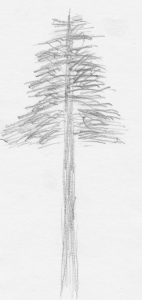The Douglas-fir (Pseudotsuga menziesii) is an outstanding coniferous tree in the Pacific Northwest, and is a representative icon not only of the Cascadian bioregion, but also for Oregon (as the state tree) and i  ts timber production. They can reach as much as 90 meters in height and have a distinctive shape, holding the majority o f its leaves and branches in the upper half of the tree. Indigenous tribes used the tree primarily for firewood, but also as many wooden tools. The pitch was used not only as a caulking substance for canoes, but also as a medicinal salve for skin ailments. The species tends to take over big swaths of land, and can encroach on oak savanna populated by Oregon white oak (Quercus garryana). The indigenous people saw the threat that it posed to the Oregon white oak’s acorn supply, and would frequently set small, controlled fires to get rid of the Douglas-fir, and keep the savanna open. The Douglas-fir is not a true fir, nor is it a hemlock: the name pseudotsuga means false hemlock. The needles are flat and greenish-yellow, about two to three centimeters long, arranged in a spiral pattern on the twig. It has one groove on the top edge and two white lines of stomatae on the underside, with sharp buds. The cones hang down and are scaled, with three-pronged bracts popping up from the overlapping scales.
ts timber production. They can reach as much as 90 meters in height and have a distinctive shape, holding the majority o f its leaves and branches in the upper half of the tree. Indigenous tribes used the tree primarily for firewood, but also as many wooden tools. The pitch was used not only as a caulking substance for canoes, but also as a medicinal salve for skin ailments. The species tends to take over big swaths of land, and can encroach on oak savanna populated by Oregon white oak (Quercus garryana). The indigenous people saw the threat that it posed to the Oregon white oak’s acorn supply, and would frequently set small, controlled fires to get rid of the Douglas-fir, and keep the savanna open. The Douglas-fir is not a true fir, nor is it a hemlock: the name pseudotsuga means false hemlock. The needles are flat and greenish-yellow, about two to three centimeters long, arranged in a spiral pattern on the twig. It has one groove on the top edge and two white lines of stomatae on the underside, with sharp buds. The cones hang down and are scaled, with three-pronged bracts popping up from the overlapping scales.
- Needles 2-3 cm long, spirally arranged; groove on top of needle, with a pair of white stomata lines underneath
- Cones hang down and are scaled; three-pronged bracts that emerge look like mice feet
- Trees can reach 70 meters tall, sometimes as much as 90
- Bottom half of trunk semi bare; most of foliage and shrubbery on top half of tree
- Like a range of sites, but prefer moist sites without fire

- Tend to invade Oregon white oak savannas. Indigenous tribes like the Kalapuya would set fires to keep the two species separated
